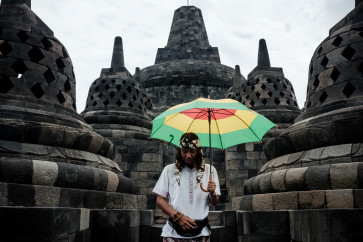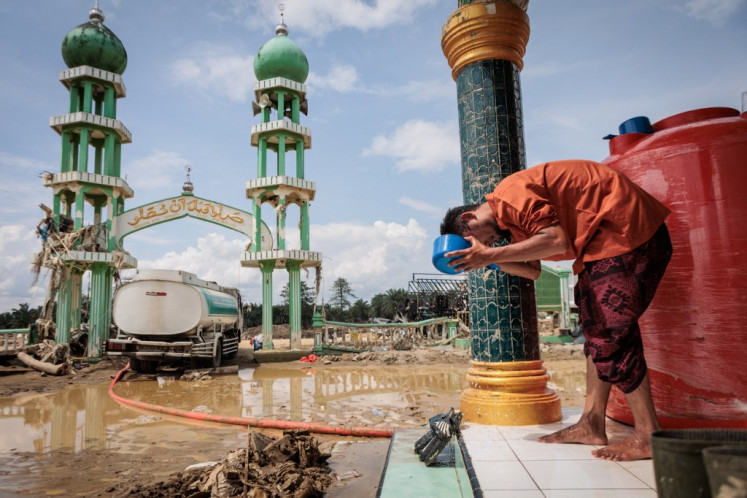Popular Reads
Top Results
Can't find what you're looking for?
View all search resultsPopular Reads
Top Results
Can't find what you're looking for?
View all search resultsRetno Maruti: A maestro of classical dance
JP/Ganug Nugroho AdiIn the world of Javanese classical dance, Retno Maruti is a maestro
Change text size
Gift Premium Articles
to Anyone
J
span class="caption" style="width: 468px;">JP/Ganug Nugroho AdiIn the world of Javanese classical dance, Retno Maruti is a maestro.
She has been delving into the art through generations, dancing nearly all her 65 years, producing novelty and infusing fresh soul into what was once seen as old-fashioned and boring traditional choreography.
Unsurprisingly, for her achievements, Surakarta Sultan Pakubuwono XII conferred the title of Kanjeng Mas Ayu (KMA) Kumalaningrum on the dancer and choreographer in 2002.
Born within the Surakarta palace complex of Baluwarti, Maruti became familiar with dance as a child. Her father, Soesiloatmadja, was a puppet master and high school teacher. She used to watch her father’s wayang shows, while her mother was her batik making and bridal makeup tutor.
It was her closeness to traditional arts that later prompted Theodora Retno Maruti to learn classical dance, gamelan music, puppet playing and tembang (poetry singing) from the age of five. She was fortunate to be a protégé of distinguished Surakarta palace instructors.
Besides her father, her classical dance teachers were KRT Koesoemokesowo, R. Ay Sukorini, Basuki Kusworogo, R. Ay Laksminto Rukmini, Basuki Kuswarogo and Bagong Kussudiarjo.
For tembang, Maruti received instruction from Bei Mardusari and Sutarman. “They contributed greatly to my present career. I feel very lucky to have been able to learn from them,” said the woman born on March 8, 1947.
She appeared for the first time outside the palace at 14 in Sendratari Ramayana (dance drama) at the Prambanan temple in 1961. Playing Kijang Kencana (the golden deer), she was widely praised, even by president Sukarno.
She had her first foreign tour in 1964, when she joined the Indonesian art mission to the New York World’s Fair.
“After the show in America I became even more convinced that dancing had become part of my life,” said Maruti, who once wanted to work as a secretary.
She was not only dancing but also creating. Her first work, Langendriyan Damarwulan, came out in 1969 as a Javanese opera. In the following year, she presented the opera at the Osaka World Exposition in Japan.
Along with her husband, Arcadius Sentot Sudiharto, Maruti set up the dance studio Padnecwara. Her creations like Damarwulan, Abimanyu Gugur, Roro Mendut, Sawitri, Sekar Pembayun, Keong Emas, Begawan Ciptoning and Alap-alap Sukesi flowed through the studio.
Nearly all her dance compositions were derived from the history of Javanese kingdoms, legends and the Ramayana and Mahabharata, depicting the struggles of female figures.
“I was born and brought up in a milieu of Javanese culture so my choreography won’t go far from this background. As a woman, I understand womanhood better, just like telling something about myself through the art,” explained Maruti, also a performing art lecturer at the Jakarta Art Institute (IKJ).
Her command of Javanese literature, tembang and wayang arts makes classical dance sequences that were previously seen as conservative become enchanting performances because of her innovations.
Such novelty can be noticed, for instance, in her Roro Mendut created in 1979. Maruti doesn’t feature the main female character, Roro Mendut, in the general version as a cigarette seller. Wiraguna in the opposite role doesn’t appear as a frail old man either.
In Sekar Pembayun, the leading figure, Sekar Pembayun, is not a quiet woman submissive to her father, but instead a vocal lady capable of arguing with Panembahan Senopati, the founder of the Mataram dynasty and her own father.
“I wish to see women speaking, expressing their aspirations and waging a struggle, regardless of winning or losing in the effort,” said the mother of dancer Genoveva Rury Nostalgia.
The other strength of Maruti is her ability to combine other cultural backgrounds with Javanese culture. She has developed close associations with choreographers of different styles and has learned Minang, Balinese, Sundanese and contemporary dance techniques.
“Enrichment is important in the creative process. Producing collaborative works with other choreographers is my way of learning from my peers,” said the woman, who was a dancer in the film Opera Jawa, an Indonesian-Austrian musical film co-produced and directed by Garin Nugroho in 2006.
Bedaya Legong Calonarang was among Maruti’s collaborative pieces with Balinese choreographer Bulantrisna Djelantik, combining Javanese bedaya court dance and Balinese traditional legong dance. After it was shown in Jakarta in 2006, Legong Calonarang also appeared at the Singapore Festival in 2007, the Schouwburg Festival in Holland in 2009 and the Bali Art Festival in 2009.
“Choreographers have their respective typical characteristics, distinguishing them from each other. Such differences should be maintained because they will just enhance collaborative works. The important thing in creation is honesty,” noted the recipient of the Cultural Award from the Art and Culture Ministry in 2003.
For Maruti, dancing is more than physical movements. By dancing, one has a spiritual experience, learning to practice self-control, mutual appreciation and cooperation. Dancing, in her view, is an exercise to immerse oneself in peace and serenity.
“Nearly all Javanese dances begin with the gesture of sembah [palms together, fingertips upward to the face]. For me, the movement is meant to glorify God, respect parents, seniors, our teachers and our audience,” said the choreographer.
While in Surakarta (Solo) to join “Solo Menari 24 Jam” (Solo dancing round the clock) on World Dance Day, Maruti expressed her pride in the preservation and promotion of dance in her place of birth. The program had around 5,000 participants performing mass dances in several corners of the city.
“Solo is our hope for the birth of the best dancers in the country. It’s not easy to gather thousands of people for mass dancing. But Solo was capable of making it come true. It was remarkable,” said Maruti.
Now as a senior artist, Maruti continues dancing. Through Padnecwara, she and her spouse are encouraging youth to love and learn classical Javanese dance. The studio is also producing dozens of dance shows while developing and preserving classical works.
“Making interpretations of our predecessors’ masterpieces is our way of preserving Javanese arts and culture. We feel grateful that Padnecwara has continued to date,” said the woman who in 2008 received a cultural medal for merit, the Satya Lencana Kebudayaan, from President Susilo Bambang Yudhoyono.
“I’m optimistic many dancers will perpetuate the beauty of Javanese classical dance. Once I was worried as quite a number of young choreographers preferred contemporary dance. But in the last few years I’ve been relieved to see the emergence of youngsters attracted by traditional dances,” Maruti said.










